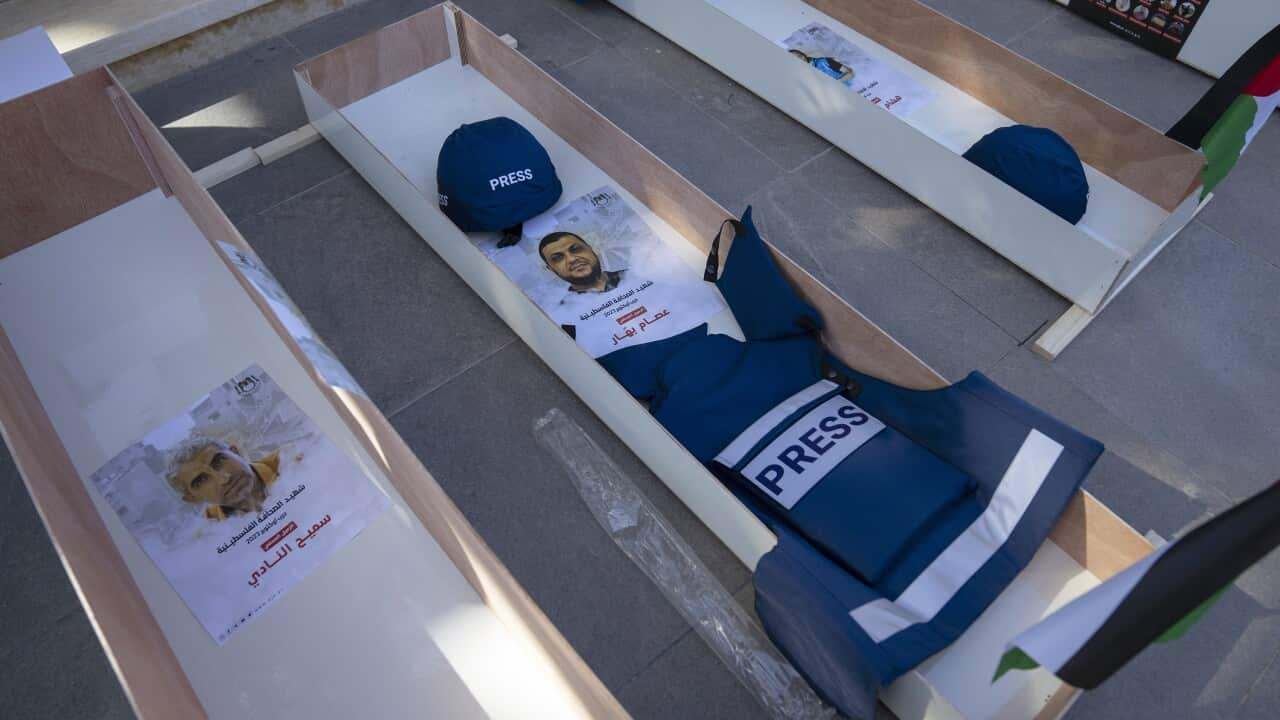Key Points
- More than 60 journalists have been killed in the Hamas-Israel war, an independent non-profit organisation said.
- Others have suffered injuries and the killing of family members in airstrikes in Gaza.
- Some journalists have fled Gaza but others remain behind.
"I'm still alive."
For the past few weeks, this is how Gaza-based filmmaker Bisan Owda has been opening her social media posts, a routine message to her legions of worldwide followers.
But in the last few days, the messages from her and other journalists in Gaza have increasingly turned more grim as a temporary, week-long ceasefire between militant group Hamas and Israel's defence forces .
In a recent post, Owda said her hope for survival had diminished.

A Palestinian journalist comforts his niece who was wounded in an Israeli strike on her family home in Nusseirat refugee camp, in a hospital in Deir el-Balah, Gaza Strip in October. Source: AP / Ali Mahmoud
"I suffer from nightmares that ... so closely resemble reality that I no longer differentiate between reality and dream."
Gaza, a Palestinian enclave run by the militant group Hamas, has been under bombardment by Israel since 7 October, when Hamas gunmen burst through the Gaza border into Israel and killed 1,200 people, mostly civilians, while also taking around 240 hostages, according to Israeli authorities.
More than 15,500 people have been killed in Gaza, according to its health ministry.
In November, said they believed Palestinians were at "grave risk of genocide" in Gaza due to continued Israeli bombardment. Israel has claimed it is targeting Hamas militants and will continue doing so until all hostages are released.
The Chief Prosecutor of the International Criminal Court has said an investigation into possible war crime violations by both Hamas militants and Israel is "a priority" for his office. The Geneva Conventions require that journalists be treated as civilians in war zones.
Journalist Motaz Azaiza, who has millions of followers on Instagram and has been documenting the war and his life in between airstrikes, said in a recent post that it was now "about life or death" and that he and others were "surrounded by Israeli tanks".
"The stage of risking everything to bring you the news has ended," wrote Azaiza in Arabic, according to a translation.
"Now begins the stage of trying to survive."
The death count among journalists covering the Hamas-Israel war continues to climb.
As of 3 December, the Committee to Protect Journalists (CPJ) has documented the killing of 61 journalists: 54 Palestinian, four Israeli, and three Lebanese.
CPJ says the first month of the Hamas-Israel war is now the deadliest month for journalists since it began documenting journalist fatalities in 1992.
The Israel Defence Forces wrote to Reuters and AFP in October after the news agencies sought assurances that their journalists in Gaza would not be targeted by Israeli strikes.
"The IDF is targeting all Hamas military activity throughout Gaza," the IDF letter said, adding that Hamas deliberately put military operations "in the vicinity of journalists and civilians".
"Under these circumstances, we cannot guarantee your employees' safety, and strongly urge you to take all necessary measures for their safety," the IDF letter concluded.
According to an interactive map from CPJ, most of the journalists have been killed in Gaza's north. The IDF in October had ordered 1.1 million people to evacuate south, ahead of its ground operation.
The organisation said reporters in Gaza in particular had paid an "unprecedented toll" and continue to face "exponential threats".
"Many have lost colleagues, families, and media facilities, and have fled seeking safety when there is no safe haven or exit," Sherif Mansour, CPJ's Middle East and North Africa program coordinator said in a statement.

Palestinian journalist Mohammed al-Aloul carries the body of his child killed in the Israeli bombardment of the Gaza Strip, at a hospital in Deir al Balah in November. Source: AP / Fatima Shbair
In a post on Instagram on the weekend, she said Montaser Al-Sawaf was left bleeding for half an hour without any ambulances to rescue him.
"We, his colleagues, were obligated to write breaking news on his killing," Khoudary wrote.
"We reported his killing with our tears. We have been reporting on the killing of our beloved ones since day one.
"Montaser chose to stay in Gaza. He was one of the few colleagues that stayed and risked his life to report on what was happening in the north."
Turkish news agency Anadolu said Al-Sawaf was freelancing for the outlet.
Commenting on his death, Anadolu president Serdar Karagöz said the agency would "fight for those responsible for these attacks to be held accountable under international law".

Mourners attend the funeral of Palestinian TV journalist Mohammad Abu Hattab, who had been reporting live on-air for Palestine TV when thirty minutes later, upon his return home, the correspondent and his family members were killed, according to colleagues. Source: AAP / Youssef Alzanoun/Middle East Images/ABACA
In a recent post, Alaqad said leaving was "one of the hardest decisions" she took, after earlier writing that she stopped wearing her press vest and helmet reporting around Gaza because she didn’t feel safe wearing them.
Others, like 35-year-old photographer Ali Jadallah, have chosen to stay behind but farewelled loved ones who had evacuated.
On Sunday, Jadallah said goodbye to his wife and two children as they left the Gaza Strip towards Egypt.
"After 58 days of displacement, homelessness, grief and bombardment they will leave the City," he wrote in an Instagram story post.
"I did not leave with them, I am still in Gaza."
- Additional reporting by Reuters.











